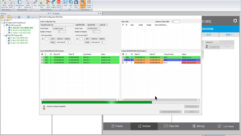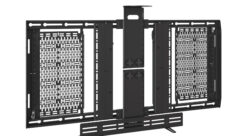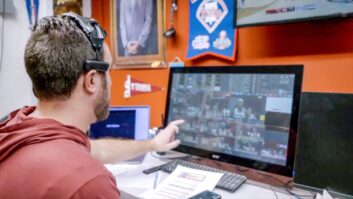INTERFACING a security system with DSL
Nov 1, 2000 12:00 PM,
Steve Filippini
Remember the good old days, when a single pair of telephone wires was all you needed to communicate with your friends and relatives? In today’s world, you are expected to have two or three lines routed into your home to allow Internet access without restricting the time you want to reach out and touch someone. Some homes are already pre-wired with multiple pairs of telephone wires from the street. Other homes only have a single pair of wires that end at the demarc (short for demarcation), which is the termination block at your home for telephone wires. It is usually located on the outer wall of the building and provides an interface between the telephone company and the home’s telephone wires.
A pair of copper wires that originate from a POTS (plain old telephone service) line used to be the standard. The POTS line was designed to carry analog signals. Analog wave transmissions are created when an input device (a standard telephone set, for example) takes an acoustic signal and converts it into an electrical equivalent in terms of volume (signal amplitude) and pitch (frequency of wave change).
The POTS line was designed to carry frequencies from zero to 4 kHz, which is partially because the voice frequencies used for speech range from around 100 Hz to more than 6 kHz. Because intelligible speech falls between 200 Hz and 4 kHz, there was no need to extend the frequency range any higher. The frequency range from 0 Hz to 4 kHz is the voice pass bandwidth (or VF channel). The telephone company fine-tuned its equipment even further by restricting the voice pass bandwidth to frequencies between 300 Hz and 3.3 kHz to remove any white noise that might be present in the outer frequency ranges.
DSL technologyThe POTS line can also carry digital information. If you are in contact with the Internet, the information it provides is digital. As it leaves the Internet server, it is converted (modulated) into an analog signal. When it reaches your home, the modem at your PC demodulates the signal back into its original digital form.
Although standard telephone lines were capable of supporting both voice and data, the technology that was available to do both at the same time and retain quality was lacking. This is where the need for a DSL (Digital Subscriber Line) telephone line came in. DSL is the technology that combines high-speed data and voice signals and transmits them over a pair of copper wires. Voice information remains in the lower frequencies, and data information has been elevated to the higher frequencies. DSL providers maintain a safe distance between the two to avoid conflicts and distortion.
In order to do this, you need to add some devices to your existing telephone line once the service has been provided. First, you need filters, which will allow your existing telephone sets to continue working in the new environment. The most common filter you will add is called a low-pass filter. This will remove any conflicting data frequencies that may interfere with normal voice frequencies while allowing high-speed digital communication with your computer. These filters will need to be added to each telephone jack that has a standard telephone set.
So far so good. You can use the telephone and access your favorite Van Halen website at the same time. What if the home has a monitored security system? The security system needs to have the telephone wires routed through an RJ31X. The RJ31X is required to achieve line seizure when the security system is attempting to report an alarm condition to the central monitoring center. This ensures the communication path from the security system to the central monitoring center is not compromised by something inside the home. Even if the home has more than one pair of telephone wires daisy-chained throughout the premises, the RJ31X is wired before anything else.
When you combine the DSL technology with a security system, chances are that the system will experience communication problems unless the proper corrective steps are taken. Because almost all security systems on the market today use analog technology, you will need to add a low-pass filter at the RJ31X. Most technicians may assume that by adding a low-pass filter at that point, the problem is solved. Unfortunately, by adding a filter at the RJ31X, you will prevent the high frequencies used for data from reaching the DSL modem.
You are now faced with two options. The first is to use a second telephone line for the sole purpose of supporting the security system. This may not be possible if the home is equipped with only one pair of wires from the street. It is not the most economical way to go, either. Your customer probably bought the DSL service to reduce the number of lines coming into the home.
The second option is to homerun a pair of telephone wires to the demarc from the DSL modem. This will provide two branches of telephone lines. One branch will be used for the analog devices in the home, the other branch for the digital devices. Install a filter on the analog branch, and leave the data branch alone.
Depending on the home’s architecture, you may or may not have a problem running a separate telephone line for the DSL modem. If a second branch is available at the demarc, the DSL technician may install a splitter. This provides a clean interface between the analog and digital devices. If you do not have the second branch, you run the risk of interfering with the communication path of the security system. In the event that there is only one branch of telephone wires at the demarc, you owe it to your customer to advise him of the possible problems he may encounter.
Keep one more thing in mind. Even if you homerun the DSL modem back to the demarc, there is still a chance that something may compromise the communication path from the security system. Many DSL modems have an analog port that provides an input for 56K modems. The analog modem can be used for PC-based answering machines and FAX programs. Some people find it convenient to plug in a telephone set and have it available at the computer desk. Keep in mind that whenever this analog device is online, the security system will not be able to seize the telephone line properly in an emergency.
New opportunitiesDSL installations began in 1998 and will greatly increase over the next several years. Security systems have been around a lot longer and will continue to provide peace of mind to their users. If you are in the business of providing either type of service, you will be busy. The key to surviving this new technology is education.
Advise your customers that they should test their security system with the central monitoring center before and after the DSL service has been installed. It is a good idea for your customer to inform the DSL technician that the home has a monitored security system. This will give the DSL technician an opportunity to identify and make the necessary changes to the telephone wiring while on site.
Also, if you know that your customer is planning to have a DSL service installed, extend the offer to come out to their home to verify the existing wiring configuration. This will give you an opportunity to suggest a couple of options in avoiding any future problems.
Moreover, learn as much as you can about the type of DSL service offered in your area. This will greatly reduce the possible downtime your customer’s security system may experience. Most DSL providers will work with you in providing information and technical support when the need arises, but remember to be patient with your DSL technician. Like you, he may be entering uncharted territories.
If you happen to be the DSL provider, take a moment to ask your customer if there are any devices on the telephone line that may be affected by this new service. DSL providers are usually good at asking about modems and FAX machines, but they tend to overlook the security system.
As technology in the world of communication evolves and expands, we cannot forget the legacy systems we maintain for our customers. Someone will eventually design a module that eliminates the need for special wiring and interfacing. Until then, look on the bright side. They never fail to keep our jobs interesting.







